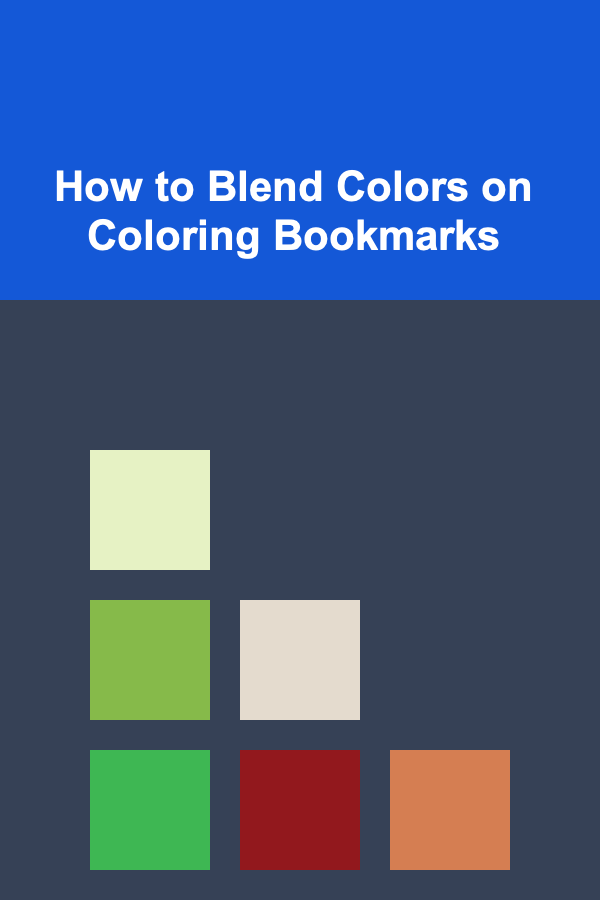
How to Blend Colors on Coloring Bookmarks
ebook include PDF & Audio bundle (Micro Guide)
$12.99$10.99
Limited Time Offer! Order within the next:

Coloring bookmarks is an enjoyable and creative activity that allows individuals to express their artistic flair while creating functional pieces of art. The process of blending colors on bookmarks is not only about filling in spaces but also about creating a harmonious flow of shades that enhances the design. Whether you're using colored pencils, markers, or watercolors, blending colors can bring your bookmark to life. In this article, we will explore the art of blending colors on bookmarks, covering the techniques, tools, and tips to achieve a seamless and beautiful result.
Understanding the Basics of Color Blending
Before diving into the techniques of blending colors, it's essential to understand the basics of color theory. Knowing how colors interact with each other, how to mix complementary and analogous colors, and how to create gradients can help you make informed decisions while coloring.
Color Wheel and Its Importance
The color wheel is a fundamental tool that helps us understand how colors relate to one another. It consists of primary colors (red, blue, and yellow), secondary colors (orange, green, and purple), and tertiary colors (mixtures of primary and secondary colors). On the color wheel, complementary colors (colors opposite each other) and analogous colors (colors next to each other) play a crucial role in creating balanced and visually appealing designs.
- Complementary colors create contrast and vibrancy, making each color pop.
- Analogous colors blend smoothly together, creating a harmonious and cohesive feel.
When blending colors on bookmarks, selecting the right colors from the wheel can make your design either stand out dramatically or flow smoothly from one hue to the next.
Choosing the Right Materials
The materials you use will significantly impact the blending process. Different coloring mediums have their unique characteristics, and selecting the right one depends on the desired effect. Here's a breakdown of some popular materials used for coloring bookmarks:
Colored Pencils
Colored pencils are versatile and commonly used for coloring bookmarks. Their ability to layer and blend makes them ideal for achieving a smooth gradient effect.
Tips for blending with colored pencils:
- Layering: Start by applying a light layer of color and gradually build it up to create a smooth transition.
- Blending tools: Use a blending stump, tissue, or a colorless blender pencil to smooth out the color.
- Pressure control: Vary the pressure on your pencil to create different intensities of color and facilitate blending.
Markers
Markers can produce vibrant, bold colors and are particularly effective for adding saturation to designs. Alcohol-based markers are ideal for blending, as they have a smooth flow and allow for seamless transitions.
Tips for blending with markers:
- Use a blending marker: Alcohol markers often come with a blending marker, which helps to merge colors together seamlessly.
- Layering technique: Apply one color first, then use the blending marker or a second color to blend the edges.
- Quick blending: Since markers dry quickly, work in small sections to avoid uneven blending.
Watercolors
Watercolors provide a soft, translucent effect, perfect for creating delicate, ethereal color transitions. The nature of watercolors allows for easy blending but requires more control and patience.
Tips for blending with watercolors:
- Wet-on-wet technique: Apply water to the paper before adding color to create smooth gradients.
- Gradual build-up: Layer the color while the paper is still damp to achieve smooth transitions.
- Avoid overworking: Watercolors can become muddy if blended too much, so it's essential to strike the right balance.
Blending Techniques for Beautiful Bookmarks
Now that you understand the materials and the basics of color theory, let's dive into the specific techniques for blending colors on bookmarks. The goal is to create smooth transitions that evoke a sense of movement and depth. Below are several techniques to help you master the art of blending.
1. The Layering Technique
Layering is the foundation of color blending. It involves applying multiple layers of colors to gradually build up depth and achieve a smooth transition from one shade to another.
- Start light: Begin with a light layer of your base color and gradually build up the intensity.
- Add secondary colors: Once the base layer is dry, add the secondary color where you want the transition to occur.
- Blend with pressure: Use varying pressure on your tool to merge the colors and soften the lines between them.
This technique works best with colored pencils and markers but can also be used with watercolors when applied in layers.
2. The Gradient Technique
A gradient is a smooth transition from one color to another, often from dark to light or vice versa. Gradients can be applied to any coloring medium, but achieving a seamless gradient requires patience and attention to detail.
- Work from light to dark: Start with the lighter color and gradually add darker shades.
- Blend while wet (watercolors): With watercolors, apply the lighter color first and add a darker color while the paper is still wet.
- Use a blending tool (colored pencils): If using colored pencils, use a colorless blender pencil to merge the colors together.
Gradients are excellent for creating depth and can make your bookmark look more dynamic and visually appealing.
3. The Feathering Technique
Feathering is a technique where you lightly apply color in small strokes that gradually fade into each other. This technique works well for creating soft transitions, especially when working with colored pencils or markers.
- Apply small strokes: Use light, quick strokes to apply the color in small sections.
- Blend the edges: As the strokes begin to overlap, use a blending tool or your finger to gently smooth the transition.
Feathering works best when you want a more subtle, airy transition, and it's perfect for backgrounds or creating the illusion of texture.
4. The Smudging Technique
Smudging is often used to soften the transition between colors, giving your bookmark a softer, blended appearance. This technique can be applied to colored pencils, pastels, and charcoal, but it works particularly well with colored pencils.
- Apply color generously: Use your colored pencils to apply a substantial amount of color to the bookmark.
- Smudge the edges: After applying the color, use a blending stump, tissue, or your finger to gently smudge the colors where they meet.
- Avoid harsh lines: The goal of smudging is to remove any harsh lines or edges, creating a smooth and continuous transition.
This technique is ideal for creating a soft, dreamy look and is great for backgrounds or adding depth to your designs.
5. The Wet-on-Wet Technique (Watercolors)
Watercolors are unique in their ability to blend directly on the paper. The wet-on-wet technique involves applying a layer of water to the paper before adding the paint, allowing the colors to blend seamlessly.
- Moisten the paper: Start by lightly wetting the area of the bookmark you plan to paint.
- Add color: Drop watercolor onto the wet surface, allowing the pigment to spread and blend naturally.
- Control the flow: You can control the amount of blending by adjusting the amount of water used and how much color is added.
The wet-on-wet technique creates beautiful, fluid transitions, making it an excellent choice for bookmarks with nature-inspired designs, such as skies, oceans, or sunsets.
6. The Dry Brush Technique (Watercolors)
In contrast to the wet-on-wet technique, the dry brush technique allows you to create more textured, controlled effects. This technique is particularly useful when you want to highlight certain areas of your bookmark or add details after blending larger sections.
- Use minimal water: Dip your brush into watercolor with minimal water and apply it to dry paper.
- Create texture: Use quick, short strokes to create a textured look that contrasts with smooth areas of blended color.
The dry brush technique is perfect for adding intricate details or creating a textured, layered effect.
Common Mistakes and How to Avoid Them
While blending colors on bookmarks is an enjoyable activity, there are some common mistakes that can occur, especially for beginners. Here are a few pitfalls to avoid:
1. Over-Blending
Blending too much can result in muddy colors and a lack of definition. Always remember that a little blending goes a long way. Work in small sections, and be mindful of not overworking the colors.
2. Not Layering Enough
If you don't layer enough color, your transitions may appear too harsh or undefined. Be sure to gradually build up color, especially when working with colored pencils or markers, for smoother gradients.
3. Using the Wrong Tools
Each medium has specific tools that work best with it. For example, using a colorless blender with markers or watercolors won't achieve the same effect as with colored pencils. Always choose the correct tool for the medium you're working with.
4. Ignoring Color Theory
While it's tempting to use any colors that appeal to you, understanding color relationships can drastically improve your blending. Be mindful of complementary and analogous colors to create harmonious or contrasting effects.
Conclusion
Blending colors on bookmarks is a creative and rewarding way to enhance the beauty of functional art. Whether you're using colored pencils, markers, or watercolors, the key to mastering the art of blending is practice, patience, and understanding the materials you're working with. By using the right techniques, tools, and color theory, you can create bookmarks that not only serve as placeholders but also as stunning pieces of artwork.
As you continue to experiment with different blending methods, you'll develop your own unique style, and each bookmark will become a masterpiece in its own right. So grab your coloring tools, get inspired, and let your imagination guide you as you explore the endless possibilities of color blending.
Reading More From Our Other Websites
- [Home Holiday Decoration 101] How to DIY Holiday Garlands and Banners for a Festive Touch
- [Home Budget Decorating 101] How to Decorate Your Home Like a Designer on a Budget
- [Home Lighting 101] How to Mix Ambient, Task, and Accent Lighting in Your Home
- [Organization Tip 101] How to Organize Craft Supplies in the Family Room
- [Organization Tip 101] The Benefits of Using Kitchen Cabinet Refacing Kits for a Budget-Friendly Upgrade
- [Home Renovating 101] How to Achieve the Best Bathroom Makeovers on a Budget
- [Home Soundproofing 101] How to Soundproof Your Home to Create a Meditation Space
- [Personal Care Tips 101] How to Use Shampoo to Prevent Hair Thinning
- [Star Gazing Tip 101] Star Trails Explained: Planning, Shooting, and Post-Processing Tips
- [Stamp Making Tip 101] Eco-Friendly Rubber Stamp Making: Sustainable Materials and Practices

How to Budget for Home Insurance and Other Necessary Expenses
Read More
How to Deal with Critters in Your Tent
Read More
How to Offer Group Music Lessons and Increase Your Earnings
Read More
How to Streamline Communication Tools in Your Virtual Workspace
Read More
How To Use Humor in Your Content
Read More
10 Tips for Improving Walkability in Your Community
Read MoreOther Products

How to Budget for Home Insurance and Other Necessary Expenses
Read More
How to Deal with Critters in Your Tent
Read More
How to Offer Group Music Lessons and Increase Your Earnings
Read More
How to Streamline Communication Tools in Your Virtual Workspace
Read More
How To Use Humor in Your Content
Read More